Are you ready to embark on a captivating journey through the fascinating world of monkeys?
These remarkable creatures, found in various regions across the globe, never cease to amaze with their diverse adaptations and unique habitats.
From the dense rainforests of Africa to the vibrant landscapes of Asia and the lush jungles of Central and South America, each corner of the world offers a different type of monkey waiting to be discovered.
So, get ready to be enthralled by the captivating stories of these primates and the secrets they hold.
Monkeys Found in Africa
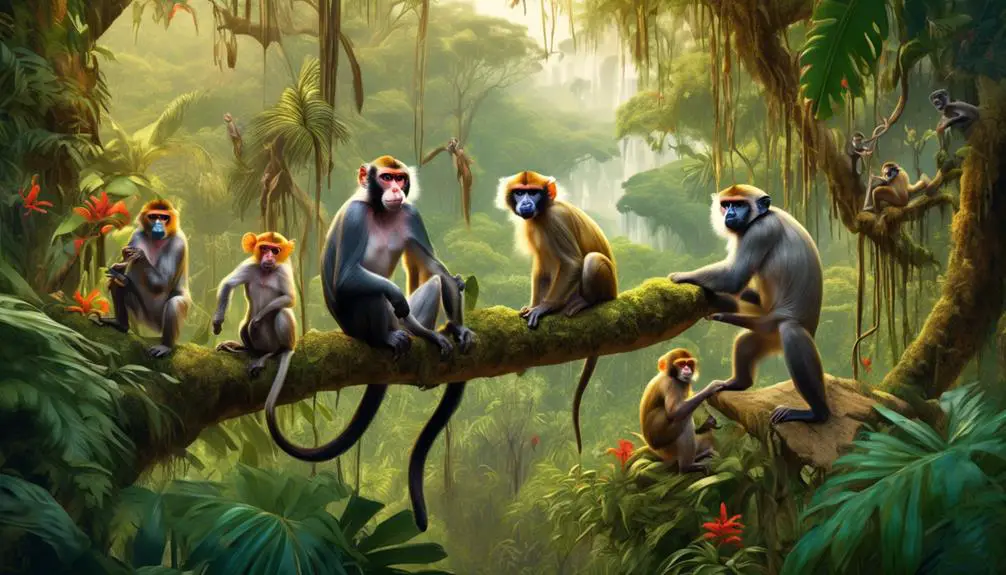
Monkeys found in Africa include the Mona Monkey, Olive Baboon, and Blue Monkey, each with distinct identifying features and habitats.
The Mona Monkey, scientifically known as Cercopithecus mona, is characterized by its brown agouti fur, white rump, black legs and tail, and blue-grey face with stripes across. It’s classified as Near Threatened and can be found in forests and rainforests in various national parks and sanctuaries in Nigeria, Ghana, Cameroon, Senegal, Congo, and Angola.
The Olive Baboon, known as Papio anubis, has an olive-colored coat and a long square muzzle with large protruding nostrils. Males have long hair draped from head to shoulders. This species is classified as Least Concern and inhabits savannahs, grasslands, deserts, and rainforests in various national parks in Ethiopia, Tanzania, Mali, and Chad.
The Blue Monkey, scientifically named Cercopithecus mitis, has yellowish patches on its face, a bare face, and an olive-grey coat. It’s also classified as Least Concern and can be found in the Congo basin and rainforests in Somalia, Angola, Burundi, Ethiopia, Kenya, Malawi, Mozambique, Rwanda, South Africa, and the Democratic Republic of the Congo.
These monkeys in Africa exhibit distinct characteristics and occupy diverse habitats, contributing to the rich biodiversity of the region.
Monkeys Found in Asia

Found in various countries across Asia, the monkeys in this region display a wide range of species, each with unique characteristics and habitats. One of the monkeys found in Asia is the Barbary Macaque (Macaca sylvanus). This endangered species is known for its thick, brown-yellow fur, absence of a visible tail, and presence of cheek pouches. The Barbary Macaque primarily inhabits the pine woods of the Atlas and Rif Mountains in Morocco, Algeria, Libya, Tunisia, and even Gibraltar.
Another monkey species found in Asia is the Rhesus Macaque (Macaca mulatta). It’s easily identified by its red face and rear, as well as its medium-length tail. This species is classified as least concern and can be found in urban areas, dense woodlands, and agricultural areas in Afghanistan, Pakistan, India, China, and Southeast Asia.
Lastly, the Japanese Macaque (Macaca fuscata) is another notable monkey species found in Asia. It has a silvery grey to light brown coat, a face devoid of hair, and a short tail. This species is classified as least concern and is primarily found on the major islands of Japan, including various national parks and monkey parks.
These monkeys found in Asia contribute to the rich biodiversity of the region and provide valuable insight into the adaptations and behaviors of primates in different habitats.
Monkeys Found in China

Continuing our exploration of primate diversity in Asia, we now turn our attention to China, where a fascinating array of monkey species can be found. China is home to several unique and endangered monkey species, each with its own distinct characteristics and conservation status.
| Monkey Species | Scientific Name | Identifying Features | Conservation Status |
|---|---|---|---|
| Black Snub-nosed Monkey | Rhinopithecus bieti | White faces with thick pink lips; black fur on the back, arms, and lower legs; inwardly curved nostrils | Endangered |
The Black Snub-nosed Monkey, scientifically known as Rhinopithecus bieti, is a critically endangered species found in Yunnan province, China. They have white faces with thick pink lips, and their bodies are covered in black fur on the back, arms, and lower legs. With inwardly curved nostrils, these monkeys have adapted to the cold climate of their habitat in the Baima Snow Mountain and Tacheng Black Snub-nosed Monkey National Parks.
Conservation efforts are crucial for the survival of these unique primates. The destruction of their habitat due to deforestation and human activities, combined with illegal hunting, has led to a significant decline in their population. Efforts are being made to establish protected areas and promote sustainable practices to ensure the long-term survival of the Black Snub-nosed Monkey in China.
Monkeys Found in Central and South America

A diverse range of primate species can be found in Central and South America, each with their own unique characteristics and conservation status. One such species is the Panamanian White-Faced Capuchin (Cebus imitator). This monkey has a pink face and white fur around the face and front part of the body. It’s classified as vulnerable, meaning it’s at high risk of extinction in the wild. The Panamanian White-Faced Capuchin can be found in Central America.
Another monkey species found in Central and South America is the Central American Spider Monkey (Ateles geoffroyi). This monkey has black feet and hands, with light brown, yellowish-beige, red, or whitish lighter undersides. Its face is black with eyes encircled by white. The Central American Spider Monkey is classified as endangered, indicating that it’s at a very high risk of extinction. It can be found in various countries in the Americas.
These monkeys, along with the other primate species in Central and South America, play important roles in their ecosystems. Understanding their characteristics and conservation status is crucial for their protection and the preservation of biodiversity in the region.
Other Notable Monkey Species

The Proboscis Monkey (Nasalis larvatus) is a primate species known for its reddish-brown skin color, long nose, swollen stomach, and long tail. Found in Borneo, specifically in Kutai National Park in Indonesia and Bako National Park in Malaysia, this monkey species is categorized as endangered.
The reddish-brown skin color of the Proboscis Monkey is due to the presence of carotenoids in its diet, which mainly consists of leaves, fruits, and seeds. The long nose of the male Proboscis Monkey is a unique feature that can grow up to 7 inches in length. It serves as an amplifier for vocalizations and is considered a sexually selected trait.
The swollen stomach of the Proboscis Monkey is a result of its unique digestive system, which allows it to efficiently process the leaves it consumes. The long tail of this monkey species is used for balance and helps it navigate through the trees.
The Proboscis Monkey is an important species in its ecosystem, contributing to seed dispersal and forest regeneration. Efforts are being made to protect and conserve its habitat to ensure the survival of this fascinating primate species.
Mona Monkey
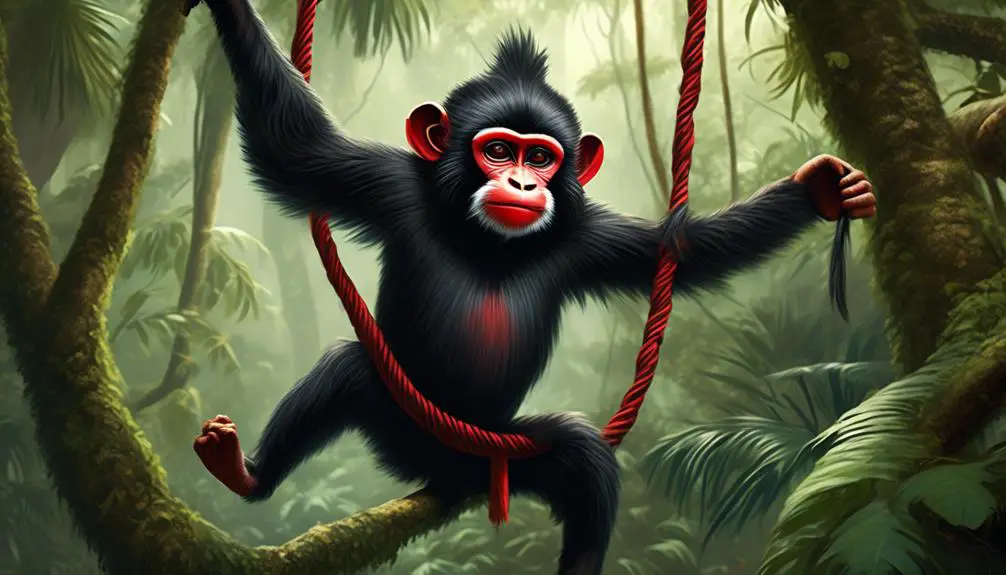
Let’s take a closer look at the physical characteristics and conservation status of the Mona Monkey.
The Mona Monkey, scientifically known as Cercopithecus mona, can be identified by its brown agouti fur, white rump, black legs and tail, and blue-grey face with stripes.
It’s classified as Near Threatened and can be found in forests and rainforests across Nigeria, Ghana, Cameroon, Senegal, Congo, and Angola.
Physical Characteristics
With its distinctive brown agouti fur, white rump, black legs and tail, and blue-grey face with stripes across, the Mona Monkey (Cercopithecus mona) displays unique physical characteristics. This species of monkey, found in forests and rainforests of Nigeria, Ghana, Cameroon, Senegal, Congo, and Angola, has an average body length of around 45 centimeters and weighs about 4 kilograms.
The Mona Monkey has a slender body, with a long tail that aids in balancing as it moves through the trees. Its face is adorned with striking blue-grey coloration, highlighted by white stripes across its cheeks. The black legs and tail provide a stark contrast against its agouti fur, which is a mix of brown and grey.
These physical features not only make the Mona Monkey visually distinct but also help it blend into its natural habitat, providing camouflage and protection.
Conservation Status
Continuing our exploration of the Mona Monkey, we now turn our attention to its Conservation Status. The Mona Monkey (Cercopithecus mona) is currently classified as Near Threatened on the conservation status scale. This means that although the species is not currently facing immediate extinction, it is at risk due to various factors including habitat loss, hunting for bushmeat, and the pet trade. The Mona Monkey primarily inhabits forests and rainforests in national parks and sanctuaries across Nigeria, Ghana, Cameroon, Senegal, Congo, and Angola. To provide a clearer understanding of the Mona Monkey’s conservation status, the table below summarizes the conservation statuses of other monkey species discussed in this article.
| Monkey Species | Conservation Status |
|---|---|
| Mona Monkey | Near Threatened |
| Olive Baboon | Least Concern |
| Blue Monkey | Least Concern |
| Barbary Macaque | Endangered |
| Rhesus Macaque | Least Concern |
| Japanese Macaque | Least Concern |
| Black Snub-nosed Monkey | Endangered |
| Panamanian White-Faced Capuchin | Vulnerable |
| Central American Spider Monkey | Endangered |
| Proboscis Monkey | Endangered |
| Red Leaf Monkey | Least Concern |
| Pygmy Marmoset | Least Concern |
| Colombian Red Howler | Least Concern |
| Northern Plains Gray Langur | Least Concern |
Understanding the conservation status of the Mona Monkey and other monkey species is crucial for developing conservation strategies to protect their populations and preserve their habitats.
Olive Baboon
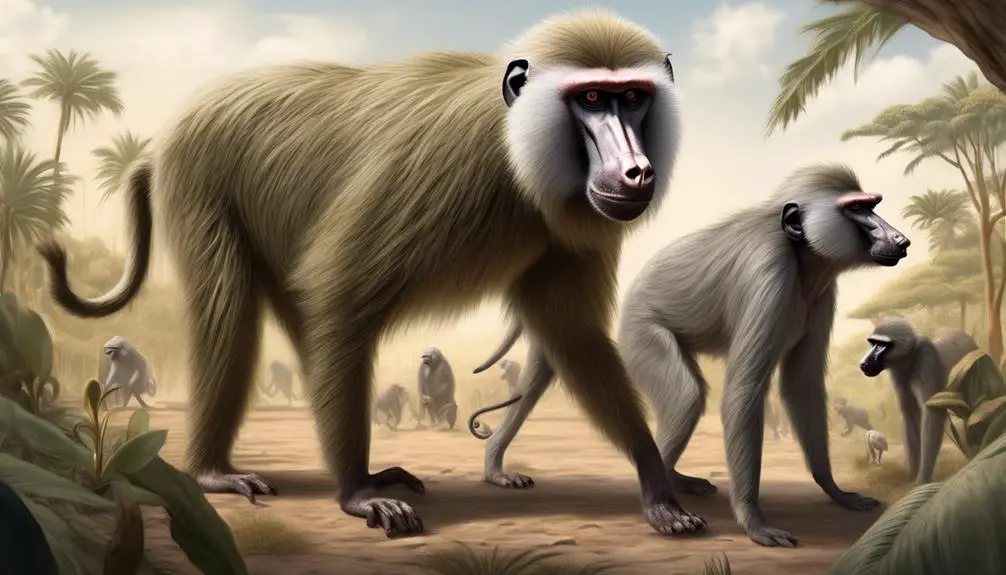
The Olive Baboon, scientifically known as Papio anubis, is a primate species found in various national parks in Ethiopia, Tanzania, Mali, and Chad. These baboons are characterized by their olive-colored coat and have a distinctive long square muzzle with large protruding nostrils. Males of this species also have long hair draped from their head to shoulders. Olive Baboons are classified as Least Concern in terms of conservation status. They inhabit a wide range of habitats including savannahs, grasslands, deserts, and rainforests. They’re highly adaptable and can be found in various national parks within their range.
Olive Baboons are social animals, living in large troops that can consist of several hundred individuals. Within these troops, there’s a hierarchical structure, with dominant males at the top. They communicate through vocalizations, facial expressions, and body postures. Their diet is omnivorous, consisting of fruits, seeds, leaves, insects, and small vertebrates.
Reproduction in Olive Baboons is seasonal, with a peak in mating activity during certain times of the year. Females give birth to a single offspring after a gestation period of around 6 months. The young baboons are dependent on their mothers for care and protection for the first few months of their lives.
Blue Monkey

Now let’s turn our attention to the Blue Monkey, also known as Cercopithecus mitis. This species exhibits unique physical characteristics, including yellowish patches on the face and an olive-grey coat.
With a conservation status of Least Concern, the Blue Monkey can be found in the Congo basin and rainforests in various African countries such as Somalia, Angola, Burundi, Ethiopia, Kenya, Malawi, Mozambique, Rwanda, South Africa, and the Democratic Republic of the Congo. Its habitat and distribution are primarily centered around these lush, forested areas.
Unique Physical Characteristics
One notable physical characteristic of the Blue Monkey (Cercopithecus mitis) is its yellowish patches on the face, accompanied by a bare face and an olive-grey coat. These yellowish patches are located on the cheeks and forehead, giving the monkey a distinct appearance.
The bare face of the Blue Monkey is devoid of fur, which sets it apart from other monkey species. The absence of facial hair highlights the bright yellow coloration on the face.
Additionally, the olive-grey coat of the Blue Monkey blends well with the surrounding vegetation, providing effective camouflage in its natural habitat.
These unique physical characteristics of the Blue Monkey contribute to its overall appearance and enable it to adapt to its environment.
Conservation Status
The conservation status of the Blue Monkey (Cercopithecus mitis) is classified as ‘Least Concern.’ This status indicates that the species is not currently at risk of extinction. The Blue Monkey is found in the Congo basin and rainforests in Somalia, Angola, Burundi, Ethiopia, Kenya, Malawi, Mozambique, Rwanda, South Africa, and the Democratic Republic of Congo. It inhabits a wide range of forested areas and is adaptable to different habitats. The table below provides further details on the conservation status of other monkey species:
| Monkey Species | Conservation Status |
|---|---|
| Mona Monkey (Cercopithecus mona) | Near Threatened |
| Olive Baboon (Papio anubis) | Least Concern |
| Blue Monkey (Cercopithecus mitis) | Least Concern |
| Barbary Macaque (Macaca sylvanus) | Endangered |
While the Blue Monkey is currently not facing significant threats, it is important to monitor its population and protect its habitat to ensure its long-term survival.
Habitat and Distribution
As we shift our focus to the habitat and distribution of the Blue Monkey, it’s important to understand where this species can be found and the specific environments it inhabits.
The Blue Monkey, scientifically known as Cercopithecus mitis, is primarily found in the Congo basin and rainforests in Somalia, Angola, Burundi, Ethiopia, Kenya, Malawi, Mozambique, Rwanda, South Africa, and the Democratic Republic of the Congo.
These monkeys thrive in dense forests, preferring areas with a high canopy cover and abundant vegetation. They’re well-adapted to arboreal life, using their long tails and strong limbs to navigate through the treetops.
Blue Monkeys have a wide distribution range within their preferred habitats, allowing them to take advantage of different food sources and evade potential predators.
Barbary Macaque
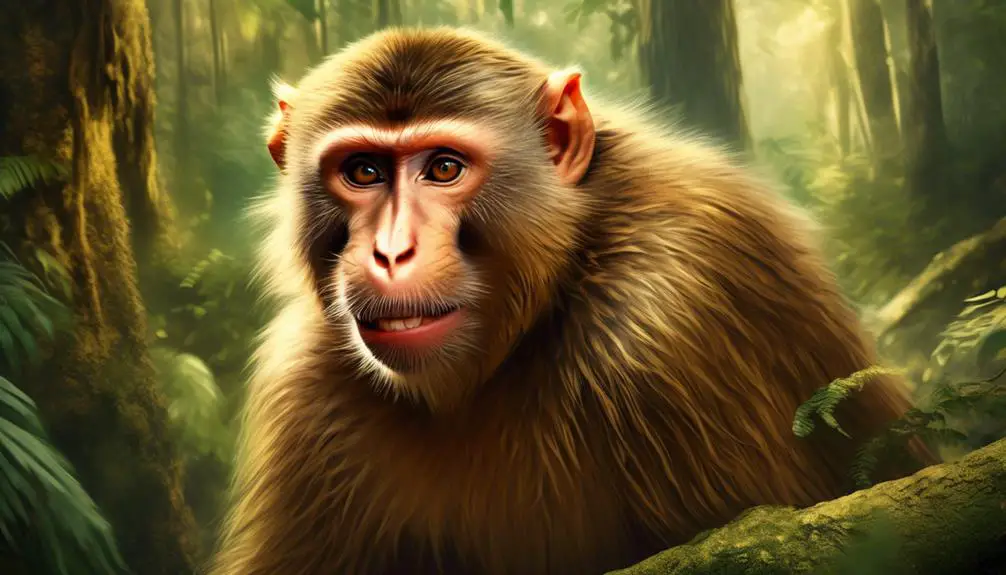
With its thick, brown-yellow fur and absence of a visible tail, the Barbary Macaque is an endangered monkey species found in the pine woods of the Atlas and Rif Mountains in Morocco, Algeria, Libya, Tunisia, and Gibraltar. Here is a table showcasing some key information about the Barbary Macaque:
| Scientific Name | Macaca sylvanus |
|---|---|
| Identifying Features | Thick, brown-yellow fur; no visible tail; presence of cheek pouches |
| Conservation Status | Endangered |
| Habitat | Pine woods of the Atlas and Rif Mountains in Morocco, Algeria, Libya, Tunisia, Gibraltar |
The Barbary Macaque, also known as the Barbary Ape, is the only species of macaque that is found outside of Asia. They have a sturdy build and can weigh up to 13 kilograms. Their fur color can vary from light brown to dark yellow, with males typically having a darker coloration than females. The absence of a tail is a distinctive feature of this species.
Barbary Macaques are highly adaptable and can live in various habitats, including forests, mountains, and even urban areas. However, they are primarily found in the pine woods of the Atlas and Rif Mountains. These monkeys are known for their cheek pouches, which they use to store food for later consumption. They are primarily herbivores, feeding on a diet of leaves, fruits, and seeds.
Unfortunately, the Barbary Macaque is currently facing numerous threats, including habitat loss, fragmentation, and illegal trade. Their populations have significantly declined over the years, leading to their classification as an endangered species. Conservation efforts are crucial to protect these unique and fascinating monkeys and ensure their long-term survival in the wild.
Rhesus Macaque
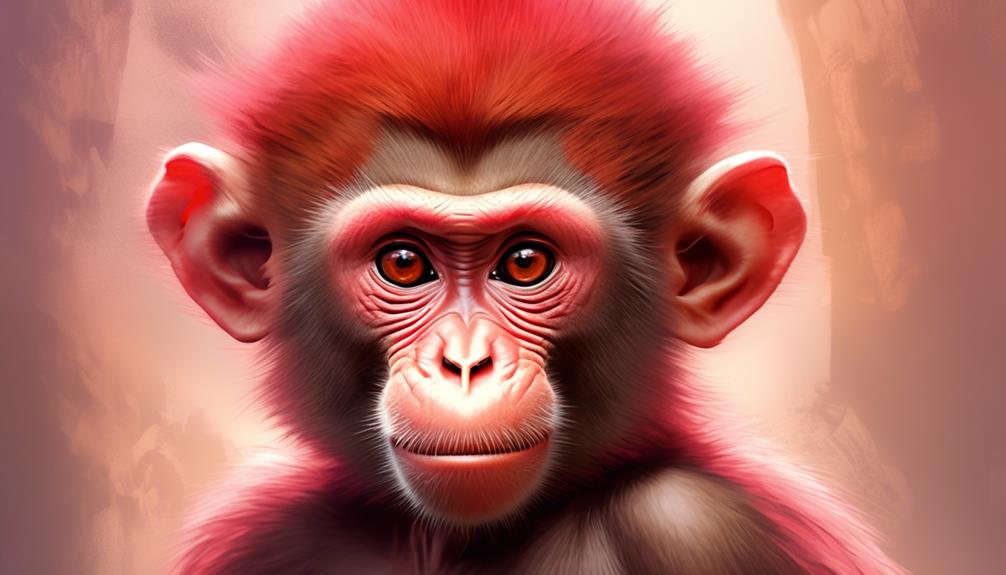
The Rhesus Macaque, scientifically named Macaca mulatta, is known for its distinctive red face and rear, as well as its medium-length tail.
In terms of behavior and social structure, Rhesus Macaques exhibit complex hierarchical systems, with dominant males leading groups of females and their offspring.
They’re widely distributed across urban areas, dense woodlands, and agricultural areas in Afghanistan, Pakistan, India, China, and Southeast Asia.
Interactions with humans can occur as Rhesus Macaques have adapted to living in close proximity to human settlements, sometimes leading to conflicts over resources and potential transmission of diseases.
Behavior and Social Structure
Rhesus macaques, scientifically known as Macaca mulatta, exhibit complex social behavior and hierarchical structures within their groups. They live in multi-male, multi-female groups, with individuals forming strong bonds and engaging in intricate social interactions.
The social structure of a group is based on dominance hierarchies, where higher-ranking individuals have priority access to resources and mating opportunities. Dominance is established through aggressive displays, such as threats and physical aggression. Females typically inherit their rank from their mothers, while males often have to fight for their position.
Within the group, grooming plays a crucial role in maintaining social bonds, reducing tension, and establishing alliances. Rhesus macaques also engage in affiliative behaviors, such as hugging, embracing, and playing, which serve to strengthen social bonds and promote group cohesion.
Geographic Distribution
Discussing the geographic distribution of Rhesus macaques, it’s important to understand where these primates can be found in order to gain a comprehensive understanding of their habitat and range.
Rhesus macaques (Macaca mulatta) are primarily found in parts of Afghanistan, Pakistan, India, China, and Southeast Asia. They inhabit a diverse range of environments, including urban areas, dense woodlands, and agricultural areas.
Rhesus macaques are adaptable and have successfully adapted to living in close proximity to humans, often utilizing human-made structures for shelter and food sources. Their ability to thrive in various habitats has contributed to their wide distribution across different parts of Asia.
Studying the geographic distribution of Rhesus macaques provides valuable insights into their ability to adapt to changing environments and their interaction with human populations.
Interactions With Humans
Interactions between humans and the Rhesus macaque (Macaca mulatta) have been the subject of extensive research due to the species’ ability to adapt and thrive in close proximity to human populations. Rhesus macaques are highly adaptable and have shown a remarkable ability to exploit human-altered environments, including urban areas, dense woodlands, and agricultural areas. This adaptability has led to frequent encounters and interactions between humans and Rhesus macaques.
In urban areas, Rhesus macaques have been known to raid crops and gardens, causing damage and conflicts with local farmers. They’re also notorious for raiding garbage bins and scavenging for food in urban areas, leading to human-wildlife conflicts. Additionally, Rhesus macaques have been observed to approach humans in search of food, often becoming habituated to human presence.
Furthermore, the close proximity of Rhesus macaques to human populations has raised concerns about the transmission of diseases. Rhesus macaques are known carriers of several zoonotic diseases, including herpes B virus and simian immunodeficiency virus. These diseases can be transmitted to humans through bites or scratches, posing a potential public health risk.
Japanese Macaque
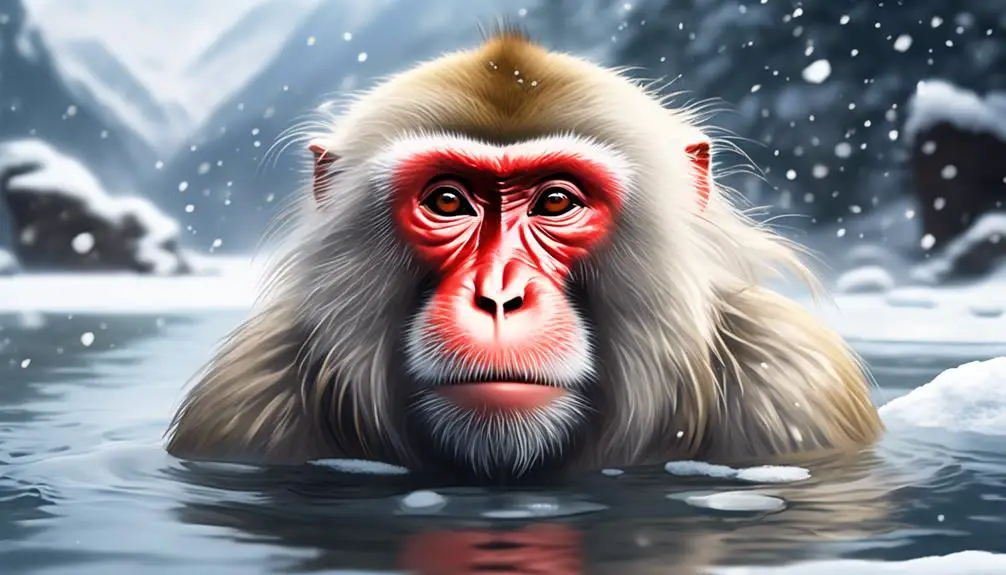
The Japanese Macaque, scientifically known as Macaca fuscata, is a species of monkey found primarily on the major islands of Japan, including various national parks and monkey parks. These macaques have a distinctive appearance, with a silvery grey to light brown coat, a face with no hair, and a short tail. They’re known for their adaptability and ability to live in a wide range of habitats, including mountains, forests, and hot springs.
Japanese macaques are highly social animals, living in troops that can consist of up to 100 individuals. They’ve a complex social structure, with dominant males leading the group and females forming strong bonds with their offspring.
The diet of Japanese macaques consists of a variety of foods, including fruits, leaves, insects, and even small animals. They’re also known for their unique behavior of bathing in hot springs during the winter, which helps them stay warm in the cold climate.
Black Snub-nosed Monkey
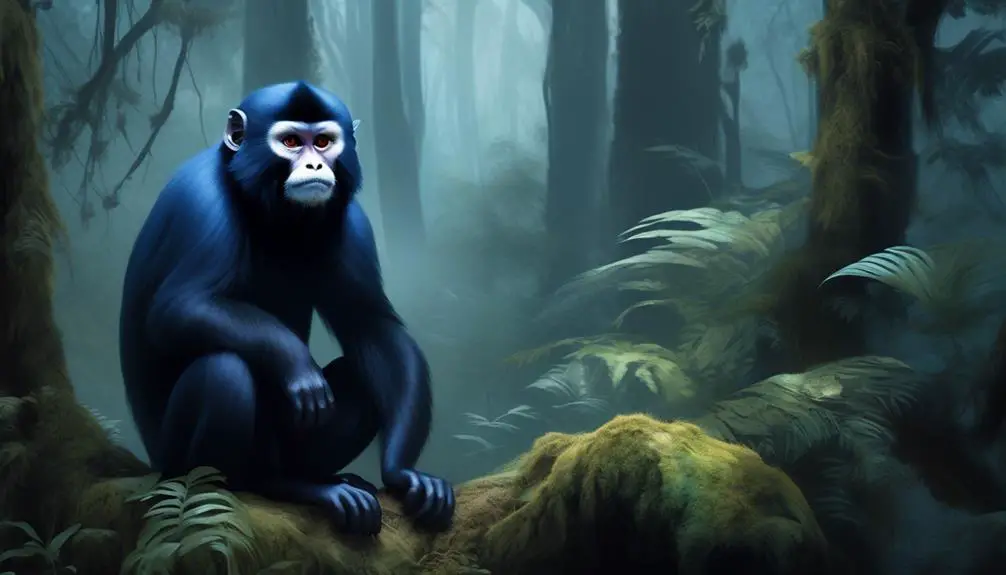
The Black Snub-nosed Monkey, scientifically known as Rhinopithecus bieti, possesses unique facial features that set it apart from other monkey species. With its white face adorned with thick pink lips and inwardly curved nostrils, this monkey exhibits a striking appearance.
However, despite its distinct features, the Black Snub-nosed Monkey faces an endangered conservation status, emphasizing the need for protection and conservation efforts to ensure its survival.
Unique Facial Features
With its distinctive white faces adorned with thick pink lips and inwardly curved nostrils, the Black Snub-nosed Monkey (Rhinopithecus bieti) possesses a unique facial feature that sets it apart from other monkey species. This striking characteristic isn’t only visually intriguing but also serves important functions for the monkey’s survival.
The white face acts as a visual signal, allowing individuals to easily recognize each other within their social group. It also enhances communication by highlighting facial expressions and gestures.
The thick pink lips and inwardly curved nostrils are adaptations to the harsh high-altitude environment that the Black Snub-nosed Monkey inhabits. These features help to warm and humidify the cold, dry air, enabling the monkey to breathe more efficiently.
Endangered Conservation Status
Moving on to the endangered conservation status of the Black Snub-nosed Monkey, let’s now examine the current challenges faced by this remarkable species.
The Black Snub-nosed Monkey (Rhinopithecus bieti) is listed as Endangered on the IUCN Red List. This species is endemic to the Yunnan province in China, specifically Baima Snow Mountain and Tacheng Black Snub-nosed Monkey National Parks.
The main threats to their survival include habitat loss and fragmentation due to deforestation, as well as hunting for their fur and body parts. These monkeys inhabit high-altitude forests and rely on a specialized diet of lichens and leaves.
Efforts are being made to protect their remaining habitat and establish conservation programs to ensure their long-term survival. It’s crucial that these efforts continue to mitigate the threats faced by the Black Snub-nosed Monkey and preserve this unique species for future generations.
Panamanian White-Faced Capuchin
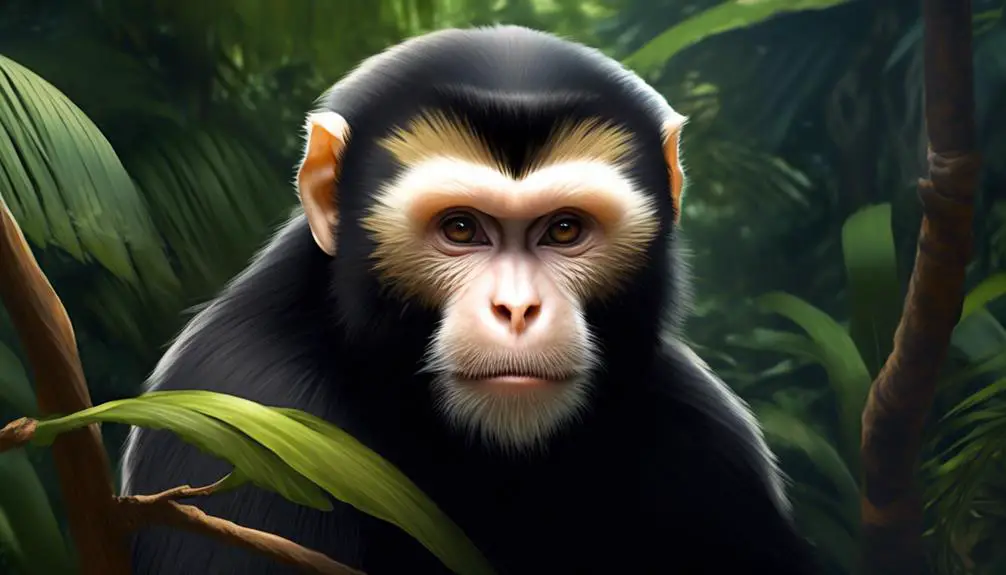
Panamanian White-Faced Capuchin, scientifically known as Cebus imitator, is a vulnerable monkey species found in Central America. This species is characterized by its pink face and white fur around the face and front part of the body. Panamanian White-Faced Capuchins have a slender body with a long tail, which they use for balance as they navigate through the trees. They have a highly dexterous prehensile tail that allows them to grasp and manipulate objects. Their diet consists mainly of fruits, seeds, flowers, and insects.
To provide a visual representation of the Panamanian White-Faced Capuchin, here is a table highlighting some key characteristics:
| Species Name | Cebus imitator |
|---|---|
| Conservation Status | Vulnerable |
| Habitat | Central America |
| Identifying Features | Pink face; white fur around the face and front part of the body |
Panamanian White-Faced Capuchins are highly social animals, living in groups of 8 to 15 individuals. Within these groups, there is a strict hierarchy, with dominant males occupying the top positions. They communicate using a variety of vocalizations, gestures, and facial expressions. This species plays a crucial role in seed dispersal and contributes to the overall health of the ecosystem. However, they face numerous threats, including habitat loss, illegal pet trade, and hunting. Conservation efforts are necessary to ensure the survival of this unique and vulnerable species.
Central American Spider Monkey

The Central American Spider Monkey, scientifically known as Ateles geoffroyi, is another monkey species found in Central America, sharing its habitat with the Panamanian White-Faced Capuchin. This species has several identifying features, including black feet and hands, light brown, yellowish-beige, red, or whitish lighter undersides, and black faces with eyes encircled by white.
The Central American Spider Monkey is classified as endangered according to the conservation status. Its habitat spans across various countries in the Americas. These monkeys prefer to inhabit tropical rainforests and deciduous forests, where they spend most of their time in the canopy, swinging from branch to branch using their prehensile tail. They’re highly skilled climbers and have long arms and legs that aid in their arboreal lifestyle.
Central American Spider Monkeys primarily consume fruits, leaves, and flowers, but they may also feed on insects and small vertebrates. They live in social groups, usually consisting of several adult females, their offspring, and one or more adult males. Communication among individuals is primarily through vocalizations and body language, including facial expressions and postures.
The Central American Spider Monkey plays an important role in seed dispersal, contributing to the maintenance and regeneration of their forest ecosystems.

Erzsebet Frey (Eli Frey) is an ecologist and online entrepreneur with a Master of Science in Ecology from the University of Belgrade. Originally from Serbia, she has lived in Sri Lanka since 2017. Eli has worked internationally in countries like Oman, Brazil, Germany, and Sri Lanka. In 2018, she expanded into SEO and blogging, completing courses from UC Davis and Edinburgh. Eli has founded multiple websites focused on biology, ecology, environmental science, sustainable and simple living, and outdoor activities. She enjoys creating nature and simple living videos on YouTube and participates in speleology, diving, and hiking.
